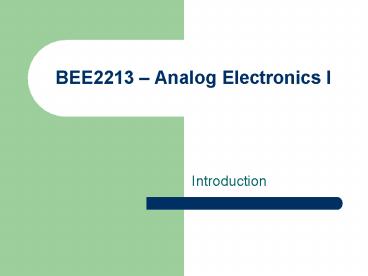BEE2213 Analog Electronics I - PowerPoint PPT Presentation
1 / 12
Title:
BEE2213 Analog Electronics I
Description:
Robert Boylestad, Electronic Devices and Circuit Theory, ISBN 0-13-394552-9, ... Theodore F. Bogart Jr., Electronic Devices and Circuits, 6th Edition, ISBN 0-13 ... – PowerPoint PPT presentation
Number of Views:1394
Avg rating:1.0/5.0
Title: BEE2213 Analog Electronics I
1
BEE2213 Analog Electronics I
- Introduction
2
Course Introduction
- NAME OF SUBJECT ANALOG ELECTRONICS 1
- SUBJECT CODE BEE2213
- LECTURE HOURS 3
- TUTORIAL HOURS 0
- LAB HOURS 2
- PRE-REQUISITE NONE
3
Lecturer
- Fairuz Rizal bin Mohamad Rashidi
- FKEE
- Phone 09-5492316
- Email fairuz_at_ump.edu.my
4
Course Synopsis
- This course presents a basic introduction to
physical models of the operation of
semiconductors devices, introduces few electronic
devices, their basic theory, and their
applications and also examines the design and
operation of important circuits that utilize
these devices. The emphasis is to familiarize
students with electronics devices and feel
certain about these devices. The primary aim is
to provide a solid foundation for students in the
areas of circuit and device design.
5
General Objective
- At the end of this course, the students should be
able to - Discuss about atom, pn junction and diode.
- Demonstrate the diode application in half wave
and full wave rectifiers, filters, regulators,
diode limiting, clamping circuit, voltage
multipliers, diode datasheet and troubleshooting. - Differentiate the special purposes diode such as
Zener diode and its application and other type of
existing diode. - Describe the concept of dc and ac biasing of a
transistor and amplifiers - Analyze common-emitter, common-base,
common-collector, and multistage amplifiers, and
also troubleshoot amplifier circuits.
6
Course Syllabus
- Semiconductor diodes (3 hours)
- Diode applications ( 6 hours)
- Bipolar Junction Transistors ( 6 hours)
- DC biasing BJT ( 9 hours)
- Field Effect Transistors ( 6 hours )
- FET biasing ( 6 hours)
- BJT transistor modeling ( 6 hours)
Diode
BJT
FET
AC Analysis
7
References
- Robert Boylestad, Electronic Devices and Circuit
Theory, ISBN 0-13-394552-9, McGraw Hill, 2000 - Thomas L. Floyd, Electronic Devices, ISBN
0-13-028484-X, Prentice Hall - Donald A. Neaman, Electronics Circuits Analysis
and Design 2nd Edition, ISBN 0-07-118176-8,
McGraw Hill, 2001 - Theodore F. Bogart Jr., Electronic Devices and
Circuits, 6th Edition, ISBN 0-13-121990-1,
Prentice Hall, 2004
8
Assessment
- Presentation / Assignment
5 - Test 1 15
- Test 2 15
- Quiz
10 - Laboratory report
15 - Final Exam 40
- Total 100
9
Class Hours
10
Classroom Policies
- Attendance Policies
- Each student is compulsory (100) to attend all
classes including lectures, tutorials,
laboratories, and fieldwork for each registered
class, including the first class session, in
order to verify registration with instructors,
and to complete all work assigned for the course. - If students do not attend the class and do not
give prior notification to the instructor of
reasons for absence and intent to attend the
class, the student shall be dropped from the
course. - Instructors of courses are not obligated to
provide make-up opportunities for students who
are absent, unless the absence has been
officially approved. An officially approved
absence, however, merely gives the individual who
missed the class an opportunity to make up the
work and in no way excuses him from the work.
11
Classroom Policies
- Classroom Conduct
- All students in the class must treat others with
civility and respect and conduct themselves
during class sessions in a way that does not
unreasonably interfere with the opportunity of
other students to learn. Failure to comply with
this requirement may result in points being
deducted from a students final numerical
average/soft skills.
12
Academic Honesty
- Your written assignments, lab and examinations
must be your own work. - Academic Misconduct will not be tolerated.
- To insure that you are aware of what is
considered academic misconduct, you should review
carefully the definition and examples provided in
Article . Code of Student Conduct, Student
Handbook, p. . If you have questions in this
regard, please contact me without delay.































